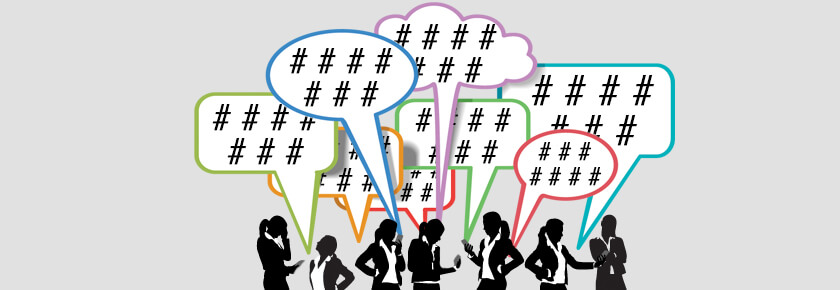A hashtag history of women on a mission.
This article was made possible because of the generous support of DAME members. We urgently need your help to keep publishing. Will you contribute just $5 a month to support our journalism?
Remember when the whole country watched state senator Wendy Davis filibuster abortion legislation in Texas? Her protest spread like wildfire because women boosted the signal on Twitter; at its peak, Davis’ filibuster averaged almost 6,000 tweets per minute. But real-time, rapid-fire commentary wasn’t enough: A hashtag, #standwithwendy, filtered out the rest of the social-media noise and created a code word for the cause. Most recently, after faux-feminist Hugo Schwyzer had a Twitter meltdown, we saw the rise of #solidarityisforwhitewoman—it addressed how he’d disparaged several of his early critics who are women of color. The hashtag ignited a thoughtful discussion about race in the feminist community, a silver lining in the Schwyzer debacle. Below, a history of hashtags that have amplified women’s issues—and where they are now:
Filmmaker Michael Moore appeared on Keith Olbermann’s show in December 2010, calling the rape allegations against WikiLeaks founder Julian Assange “a bunch of hooey.” In response, feminist blogger Sady Doyle and WAM! founder Jaclyn Friedman took to Twitter, demanding that Moore give weight to the rape accusations. Hundreds of people followed suit, using the hashtag #mooreandme to explain how rape apologism perpetuates the crime. A week later, Moore changed his tune, appearing on the Rachel Maddow Show to declare that any charge of rape “must be taken seriously.” When feminist writer Naomi Wolf brushed the allegations aside weeks later, a new crop of #mooreandme tweets emerged. Since then, it’s occasionally been used as shorthand for anybody who downplays or excuses rape. But mostly, it’s disappeared.
In early 2012, Rush Limbaugh derided Georgetown law student Sandra Fluke as a “slut” and a “prostitute” after she testified at a hearing that birth control should be covered by health insurance at religious institutions. What followed was a social media–driven movement called StopRush, a coalition of women’s rights advocates who urged Limbaugh’s sponsors to pull their ads. One group, Feminist Campus, took it further, urging people to tweet at Limbaugh’s sponsors directly with the hashtag #flushrushnow. A hundred sponsors abandoned him in the weeks after the tirade, but the movement turned out to have a slow burn: Daily Kos reported a year later that 2,471 sponsors had fled. The hashtag didn’t do it alone, and hasn’t been used since, but it was a key part of a larger strategy.
On October 8, 2012, Deborah Needleman, the editor of T: The New York Times Style Magazine, tweeted, “The sexy (sorry, feminists), smart, sassy Katie Roiphe live on stage @nypl on Wednesday night.” Needleman was clumsily referring to the false assumption that feminists bristle at sexiness, so feminists Anna Holmes and Irin Carmon responded with virtual eye rolls. “Just came back from a Pilates class. #sorryfeminists,” Holmes sarcastically tweeted. “What a cute baby. #sorryfeminists,” Carmon answered. Pretty soon, the Twitter-verse was juxtaposing the tongue-in-cheek hashtag with ultra-girly confessions, mocking the stereotype of all feminists as stodgy and butch. Journalist Ann Friedman started a Tumblr, then promptly bowed out the next day (“This meme has expired. #sorryfeminists”). Despite its short life cycle, the hashtag still shows up every so often to call out ignorance about feminism.
“They brought me binders full of women,” Mitt Romney said of his HR staff at a October 2012 debate. It was a point about equality in the workplace, but the Internet seized on its absurdity, spawning a Tumblr, Facebook group, and yes, a #bindersfullofwomen hashtag. The majority of the tweets were jokes, but a few took the opportunity as a teachable moment. “Binders full of women create cabinets full of women,” wrote Amanda Hess in Slate, arguing that employers should indeed seek out female employees. Most of the memes from the 2012 election have come and gone, but amazingly, #bindersfullofwomen has endured: A handful of tweeters used it again recently when The New York Times reported on the dearth of women in Obama’s administration.
When Port Magazine put six white, male editors-in-chief on its June 2013 cover to illustrate the “new golden age of media,” lady editors balked. Editor Amy Wallace turned her anger into a Twitter project: #womenedswelove, a hashtag accompanying shout-outs to important female editors rendered invisible by Port’s cover. The number of participants was modest, and the meme was super-niche. But it was a clear, constructive way to bring female editors to the fore—and now it’s a de facto archive of powerful women to consider for the next cover story.
Before her filibuster, Wendy Davis was an unknown Texas state senator who opposed SB5, a bill that would restrict abortions in Texas after 20 weeks of pregnancy and close 37 of the state’s 42 abortion clinics. The major networks weren’t covering her 11-hour stand in Austin the night of June 25, but fortunately, Twitter was. Live-tweeting a stream on YouTube provided by the Texas Tribune, Twitter users galvanized support for the pink sneaker–wearing state senator with their #standwithwendy hashtag, eventually scoring a tweet from Barack Obama and amassing 180,000 viewers on YouTube. The bill passed anyway, but the hashtag’s power was leveraged in other ways. The Feminist Justice League, a group encouraging direct action around a range of feminist issues, was founded on the heels of Davis’ filibuster and the social-media movement she inspired.
